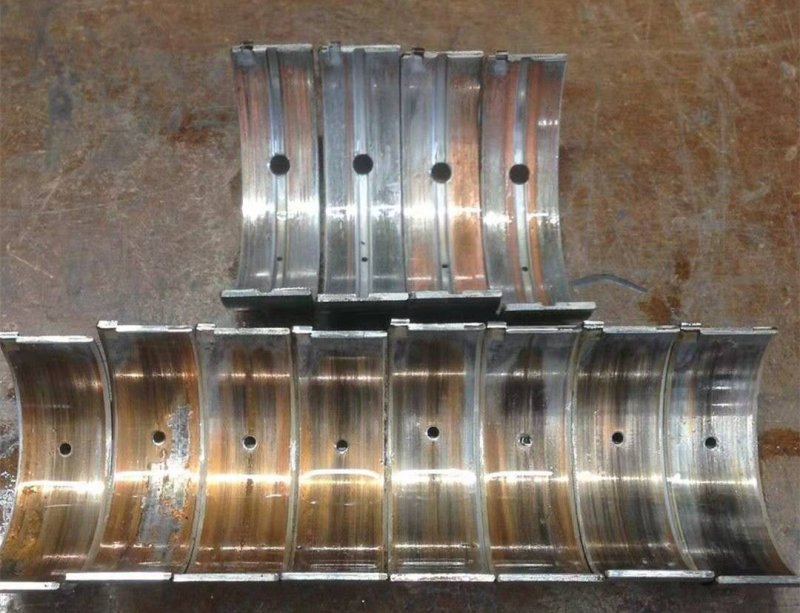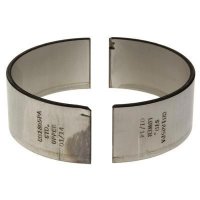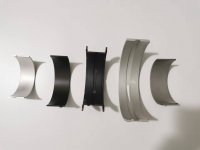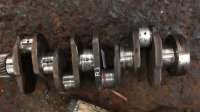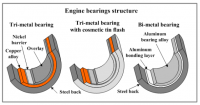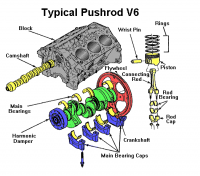The engine bearing is also called the sliding bearing, which is mainly used to support the load and the transmission movement between the crankshaft and the base. For two relatively moving parts, there must be one that is worn or damaged. Then the replacement cost of the crankshaft or the body is very expensive. Therefore, people think of adding a component that is easy to replace between the crankshaft and the body seat. That is the engine bearing. Therefore, the first damage is the engine bearing. Some experts say that the engine bearing is a fuse in the electric circuit. When the electric circuit is short-circuited, or when the load increases, the fuse is burned first.
The engine bearing are fragile components and their normal failure is wear and tear. When the working time of the engine bearing is too long, the gap between the crankshaft and the bearing exceeds the limit, the engine bearing can no longer work. Like this, the bearing wear has reached the design life, which is the normal bearing failure.
What are other engine bearing failure conditions?
First is strain
Features: rough surface, grooved, discolored
Reason analysis: the oil is not clean, entering dust or impurities; lack of oil makes the bearing in semi-dry friction; frequent cold start.
Second is bite
Features: the surface has obvious and irregular material migration, rough and deep scratches, and oxidized to blue
Reason analysis: try to start engine when the lubricating oil film is broken or lack of oil (such as improper use of oil or too small gap), large friction factor causes a large amount of frictional heat, the temperature of the engine bearing rises, then occurs the seizure. When seizure become very serious, the rotation of the cankshaft can no longer cut the bond point, the movement is terminated, commonly known as “holding crankshaft”, the bearing is completely damaged.
Which reasons can not form a normal lubricant oil film?
1. The manufacturing quality of the crankshaft is too bad, the surface roughness of the crankshaft is poor, and the cylindricity accuracy is low. Especiall when overhaul, the surface of the crankshaft has been grinded, the crankshaft is not well matched with the surface of engine bearing after installation. If the contact area is too small, it is difficult to form an oil film, will cause dry friction.
2. The quality of the bearing bush is bad, the alloy material is not good, the alloy material is loose, the surface roughness of the bearing is too poor to form an effective lubricating oil film between thecankshaft and the engine bearing.
3. The bearing cover is deformed, there is a gap on the back of engine bearing. The alloy and the bearing cannot be completely tightly fitted, then loosen to block the oil channel, interrupt the oil supply to cause dry friction.
4. The bearing is not installed correctly, the gap adjustment is improper, and the contact area is too large or too small, which makes it difficult to form a lubricating oil film between the crankshaft and the bearing.
5. If the bearing bolt torque is too smalll or the anti-loose measures are invalid, the bearing bush is loose, causing the gap between the crankshaft and the bearing to change, thenaffectto form the lubrication oil film.
6. The oil pump is seriously worn or the oil pump suction port filter is clogged, the oil supply pressure is low, and the oil is difficult to reach the specified lubrication part, causing dry friction.
7. The oil channelis blocked by impurities, the oil to the crankshaft is blocked, causing the crankshaft and the bearing dry friction.
8. The oil pipeline is damaged, the pressure of the oil circulation supply system drops, and the oil is difficult to reach the specified lubrication part, causing dry friction.
9. In the winter, when slamming the throttle to start engine, the oil is not pumped to the bearing under the low temperature and viscous state, and the surface temperature of the bearing is already very high to cause the metal to melt each other.
10. The engine is seriously overloaded, work in the long-timelow-speed and high-torque conditions. Because the engine speed is low, the oil pump speed is also low, and the oil supply is not enough, so that the crankshaft and the bearing form very high temperature and “burning the carnkshaft”.
11. The amount of oil in the engine oil sump is too small, and the bearing is not effectively lubricated to form dry friction.
12. The cooling water penetrates into the oil due to the damage of the cylinder head gasket and the oil radiator. The oil is emulsified and deteriorated, the viscosity is reduced or completely lost, the surface of the crankshaft and the bearing cannot form an effective oil film, resulting in more serious dry friction.
13. The fuel system hasfaulty, the fuel atomization is not good, the combustion is not complete or does not burn, so that the fuel flows into the oil sump along the cylinder wall and the oil is sparse, resulting in a decrease in viscosity and a “burning shaft”.
14. In thewinter, if the oil with excessive viscosity or too high condensation point, or adding a large amount of oil-adhesive additives to the oil indiscriminately, may cause the oil to flow too slowly in the oil passage, and can not be pumped to the bearing in time, resulting in dry friction.
15. Using inferior engine oil to lead crankshaft and bearing cannot be lubricated effectively.
In order to reduce the occurrence of such malignant failures, it is best to improve the technical technology of the operator, let operators implement the equipment operation rules carefully. Strengthen the daily maintenance of the engine, check the technical status of the engine at any time. Once find out abnormal conditions and stop machine to inspect in time.


